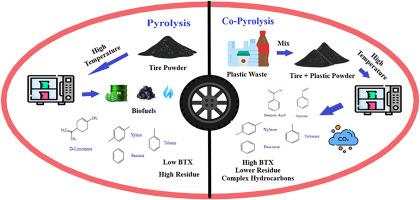Interactive co-pyrolysis of end-of-life tires and plastic wastes: A combined TGA-IR-MS and COMSOL investigation
IF 5.8
2区 化学
Q2 CHEMISTRY, MULTIDISCIPLINARY
引用次数: 0
Abstract
The accumulation of waste tires (WT) poses a significant environmental challenge due to the rubbery structure, which makes them difficult to store, digest, or recycle in typical waste recycling facilities. Thermal degradation of WT has often been investigated as a potential waste-to-energy approach, but products obtained from the pyrolysis of tires render them not suitable for direct use. Therefore, this research highlights products and degradation behavior of WT pyrolysis and their co-pyrolysis with plastic wastes such as polyethylene (PE), polypropylene (PP), and polyethylene terephthalate (PET). The integrated TGA-IR-MS system effectively mimics real-life thermal degradation and gas evolution processes by sequentially analyzing the decomposition behavior, gaseous emissions, and final pyrolysis byproducts, which resemble those found in large-scale industrial thermal recycling systems. The results revealed that plastic waste alters the thermal profile of WT, reduces residue formation, and promotes the conversion of D-limonene into BTX compounds (benzene, toluene, xylene) via radical mechanisms. Moreover, the experimental setup was modeled using COMSOL to understand the temperature profile. Outcomes reported herein address multiple Sustainable Development Goals (SDGs), specifically related to affordable and clean energy and sustainable cities (7, 11, and 13).

废旧轮胎和塑料废弃物的交互共热解:TGA-IR-MS和COMSOL联合研究
由于橡胶结构,废旧轮胎的堆积对环境构成了重大挑战,这使得它们难以在典型的废物回收设施中储存、消化或回收。WT的热降解经常被研究作为一种潜在的废物转化为能源的方法,但从轮胎热解得到的产品使它们不适合直接使用。因此,本研究重点研究WT热解及其与聚乙烯(PE)、聚丙烯(PP)、聚对苯二甲酸乙二醇酯(PET)等塑料废弃物共热解的产物和降解行为。集成的TGA-IR-MS系统通过顺序分析分解行为、气体排放和最终热解副产物,有效地模拟了现实生活中的热降解和气体演化过程,类似于大型工业热回收系统。结果表明,塑料废弃物改变了WT的热分布,减少了残渣的形成,并通过自由基机制促进了d -柠檬烯转化为BTX化合物(苯、甲苯、二甲苯)。此外,利用COMSOL对实验装置进行建模,了解温度分布。本文报告的成果涉及多个可持续发展目标(sdg),特别是与负担得起的清洁能源和可持续城市相关的目标(7,11和13)。
本文章由计算机程序翻译,如有差异,请以英文原文为准。
求助全文
约1分钟内获得全文
求助全文
来源期刊

Sustainable Chemistry and Pharmacy
Environmental Science-Pollution
CiteScore
8.20
自引率
6.70%
发文量
274
审稿时长
37 days
期刊介绍:
Sustainable Chemistry and Pharmacy publishes research that is related to chemistry, pharmacy and sustainability science in a forward oriented manner. It provides a unique forum for the publication of innovative research on the intersection and overlap of chemistry and pharmacy on the one hand and sustainability on the other hand. This includes contributions related to increasing sustainability of chemistry and pharmaceutical science and industries itself as well as their products in relation to the contribution of these to sustainability itself. As an interdisciplinary and transdisciplinary journal it addresses all sustainability related issues along the life cycle of chemical and pharmaceutical products form resource related topics until the end of life of products. This includes not only natural science based approaches and issues but also from humanities, social science and economics as far as they are dealing with sustainability related to chemistry and pharmacy. Sustainable Chemistry and Pharmacy aims at bridging between disciplines as well as developing and developed countries.
 求助内容:
求助内容: 应助结果提醒方式:
应助结果提醒方式:


